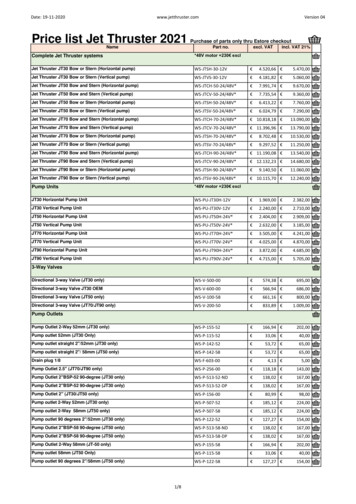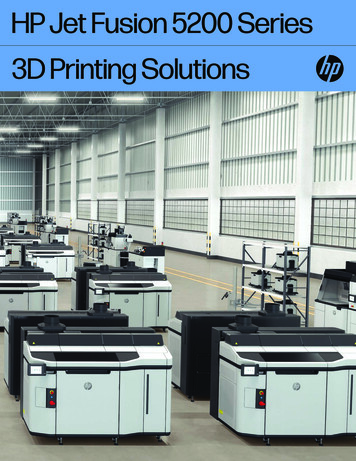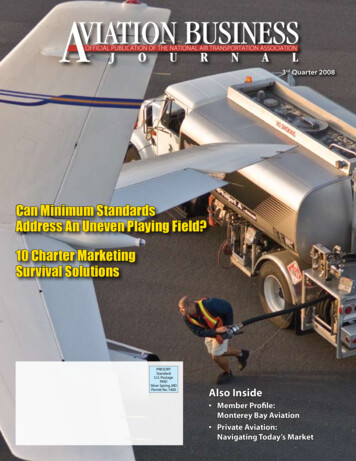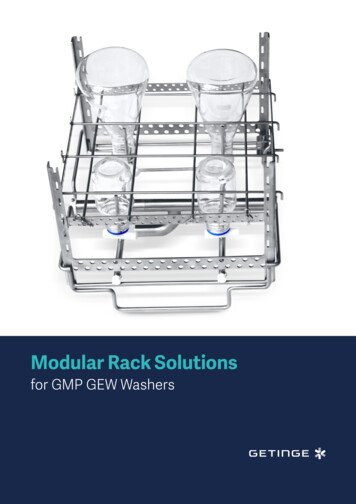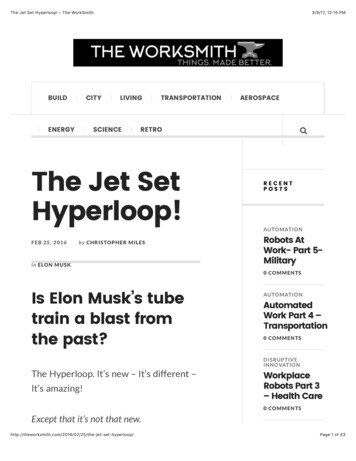
Transcription
The Jet Set Hyperloop! – The WorkSmithBUILDCITYENERGY3/9/17, 12)15 PMLIVINGSCIENCETRANSPORTATIONRETROThe Jet SetHyperloop!FEB 25, 2016AEROSPACEby CHRISTOPHER MILESin ELON MUSK!RECENTPOSTSAUTOMATIONRobots AtWork- Part 5Military0 COMMENTSIs Elon Musk’s tubetrain a blast fromthe past?The Hyperloop. It’s new – It’s different –It’s amazing!AUTOMATIONAutomatedWork Part 4 –Transportation0 COMMENTSDISRUPTIVEINNOVATIONWorkplaceRobots Part 3– Health Care0 COMMENTSExcept that it’s not that -hyperloop/Page 1 of 43
The Jet Set Hyperloop! – The WorkSmith3/9/17, 12)15 PMAEROSPACEBut it is amazing- and a little different!WorkplaceAutomationPart 2 – Travel0 COMMENTSLow pressure tube travel –Hovering. floating, levitating- Rapid lowfriction travel has been a dream- no- amission– since the first efforts in the 19thcentury to create a working pneumaticAUTOMATIONRobots – in aworkplacenear you.0 COMMENTSELON MUSKThe Jet SetHyperloop!0 COMMENTStrain. The ideas date back to the 18thconcepts of George Medhurst’s “Atmospheric Railway”.Some early designs featured a movingshoe in a pneumatic tube which pulled atrain above it. Other, more ambitious designs would place passengers in the tube.There had been experiments in Britain,efforts in France, and several demonstrations built in the U.S perloop/AIR QUALITYPRT- SelfDriving TravelPods OnDemand0 COMMENTSAIR QUALITYLighterSurfaceColorsCooler World0 COMMENTSPage 2 of 43
The Jet Set Hyperloop! – The WorkSmith3/9/17, 12)15 PMAlfred Beech’s Pneumatic Subway, New York, 1870sIndeed, a small pneumatic subway linewas opened in 1870 under Broadway inNew York!19th century pneumatic efforts deserveand may get- an additional post- whichwill profile the early risk takers- Entrepreneurs and technical men such as NewYork’s Alfred Beach and Chicago’s JoeStoetzel – as well as other bold pneumatic champions.The general hyperloop concept (as weknow it today) has been around for over100 years- The specific technology tomake such a system a reality has been invarious stages of prototype since theearly 1960’s. These were governmentagency efforts, scientific efforts –yet yperloop/Page 3 of 43
The Jet Set Hyperloop! – The WorkSmith3/9/17, 12)15 PMagency efforts, scientific efforts –yet noone person had the engineering and business skills to make such a system seem feasible to the general public.Perhaps we needed an 19th centurysalesman for the 20th century commuter. We may have needed a personpassionate about the idea of movingmany more people, much more efficiently. A true believer- who’d be able convince a skeptical public that traveling athigh speeds in a windowless tube is agood idea- A person with businesssense, a command of engineering andphysics- and little ol’ time moxy.From “The Electrical Experimenter” April1917:“ it really does not seem so ranklyimpractical to conjecture on thepossibilities of such a high speedrailway A fortune awaits the manwho is big enough for the job. It wantsanother Tesla or Edison and he isbound to arrive sooner or t-set-hyperloop/Page 4 of 43
The Jet Set Hyperloop! – The WorkSmith3/9/17, 12)15 PMbound to arrive sooner or later.”A Tesla? How about a Musk?Elon Musk’s Hyperloop IdeaBack in 2012, Elon Musk announced thathe’d soon make public a set of plans forsomething new he’d been mulling over.Musk had been stuck in traffic so oftentraveling between his Tesla and Space Xplants, that he began considering betterways to commute, He (and every otherCalifornian) knew that a High Speed railline was being planned for travel throughthe congested areas of Southern California. Certainly some high speed rail is better than what exists now. However, going by the latest estimates, by 2025 onlythe first 250 miles of bullet train trackwill exist between San Jose and Bakersfield. Total LA to -San Francisco HighSpeed Rail cost- 64 Billion -set-hyperloop/Page 5 of 43
The Jet Set Hyperloop! – The WorkSmith3/9/17, 12)15 PMHyperloop Transportation Technologies ConceptMusk, never one for thinking conventionally, decided to create a better commute.A Hyperloop. Details would beforthcoming.Musk: “It’s a cross between aConcorde, a rail gun, and an air hockeytable.”Good to his word, in August 2013 Muskreleased his Hyperloop plan. It featured alow pressure tube and an air levitatedtrain traveling high speeds, with low energy consumption. However, the big challenge he faced was one of physics- Givenhis system’s very high speeds, an air compression barrier would form in front of ahyperloop vehicle traveling in a confinedspace . Given the tight quarters in hyperloop/Page 6 of 43
The Jet Set Hyperloop! – The WorkSmith3/9/17, 12)15 PMspace . Given the tight quarters in thetube he’d planned, pressure buildup infront of the vehicle would definitely havebeen a problem. Actually, this pressurebarrier-known as the Kantrowitz Limit–wasn’t simply a problem, it was a potential showstopper:Attempting to pass a high-speedpassenger-pod through a very lowpressure tube runs squarely into theKantrowitz fluid flow limit. Historically,the solutions to working within thelimit have been “go fast” and “go slow”.A major innovation in the Hyperloopproposal provides a novel thirdapproach to remain below theKantrowitz limit while still moving athigh-subsonic velocities: adding afront-end inlet compressor to activelytransfer high-pressure air from thefront to the rear of the high-speedtransport capsule, and thus bypassingmuch of the air that would haveresulted in the dynamic shock ofthe choked -hyperloop/Page 7 of 43
The Jet Set Hyperloop! – The WorkSmith3/9/17, 12)15 PMMusk solved the problem– as did a set ofscientists and engineers in the 60s. In adecade characterized by ambitions boldenough to send men to the moon, engineers were planning trains like no onehad seen before. The jet set seemed towant- to need – travel well past thespeed of sound. Such speedy travel hadseemed possible for most of the 20thcentury, indeed patents were granted asearly as 1912. It was a matter of technology timing, political will, and money.The 20th Century’s VeryHigh Speed TrainExperimentsHigh speed travel tube experiments dateback to the earliest days of the last century. Early in the 1900’s, Professor BorisWeinberg, a Russian mechanical engineer, presented a potential travel wonder- an electromagnetic method of transporting you through a vacuum “fromNew York to San Francisco in half a set-hyperloop/Page 8 of 43
The Jet Set Hyperloop! – The WorkSmith3/9/17, 12)15 PMNew York to San Francisco in half a day”.The car of the vacuum electric systemis a three hundred-pound cylinderthree feet in diameter with conicalends hermetically sealed. You lie pronewithin it — its solitary passenger. Thereis no track. The car is really a free bodysustained by electromagnets which areplaced thirty feet apartIn true Russian fashion, this little iron passenger car was not aboutcomfort.There had been an earlier work- documented in the magnetic levitation patentof Emile Bachelet, however, in his version, there was to have been no evacuated t-hyperloop/Page 9 of 43
The Jet Set Hyperloop! – The WorkSmith3/9/17, 12)15 PMRobert Goddard’s Patented Vacuum Tube Transport (non-maglevversion)Even the famed rocket scientist, RobertGoddard, once drafted – in detail- a possible travel tube system – A 1,200 m.p.h.from New York to Boston! He’d writtenabout it in a 1909 issue of Scientific American.Goddard had worked on several tubetrain patents– His first application was tohave been a magnetically levitated andaccelerated vehicle – the actual patenthe received (posthumously) was for hissecond work, a train car levitated and accelerated by “fluid pressure between relatively movable parts”.Despite the apparent soundness of someof the aforementioned designs, the technology of the time would have madebuilding and operating any of these hyperloop/Page 10 of 43
The Jet Set Hyperloop! – The WorkSmith3/9/17, 12)15 PMbuilding and operating any of these systems nearly impossible. Unless a perfectvacuum could have been maintained, orthe vehicles designed to move incrediblyfast, these concepts would have facedsame the fundamental pressure challenge that Elon Musk did so many yearslater – The Kantrowitz Limit.Tube Pressure Wave Solution Came in 1947Tube%ight and Joseph FoaJoseph Foa & Senator Pell discuss Tubeflight next to prototype tube-1968A concept for addressing the “showstopper” air pressure problem et-set-hyperloop/Page 11 of 43
The Jet Set Hyperloop! – The WorkSmith3/9/17, 12)15 PMper” air pressure problem referencedearlier had already been (somewhat)solved by 1947:Joseph V. Foa, while working at CornellAeronautical Laboratory, was looking atboth the promise and challenges of tubetrains. Instead of employing a vacuum,his tube system combined air-cushionsuspension with jet propulsion in an entirely new way.At the time, Foa thought that a fanjet orramjet could be used to shift the air inthe front of the car to its rear. Therewould be a much smaller – (or perhapsno) air column issue to address. Therefore, the cars could go faster, and less energy would be needed to move them Inthe lab he was able to prove that such asystem would work, and propel the oncoming air around the vehicle- and wouldadd thrust!Later, after moving on to RensselaerPolytechnic, Dr Foa began working ondesigns for several very large vehiclesone of which was to be nine feet in -hyperloop/Page 12 of 43
The Jet Set Hyperloop! – The WorkSmith3/9/17, 12)15 PMone of which was to be nine feet in diameter and 195 feet long. It would hoverfrom the tube wall by way of six verylarge air cushion pods. The planned topspeed of this vehicle was some 400Mph. Foa proposed tubes that would gothrough the ground, or be slightly elevated, like a pipeline. Dr Foa continuedworking on the project at Rensselaer,and created tubeflight test vehicles aswell as an outdoor pipeline / subscaletube test rig.Larger, second version of Dr. Foa’s TubeflightDr Foa’s other design? Transcontinentalclass craft- powered by ramjets-moving supersonically, at up to 2000 miles perhour. At these speeds. and without hyperloop/Page 13 of 43
The Jet Set Hyperloop! – The WorkSmith3/9/17, 12)15 PMhour. At these speeds. and without theconcerns of weather, high speed tubetravel could have seemed quite practical.Foa felt that the tubes for these vehiclescould be either put on the surface, elevated down the center strip of superhighways, or buried underground like apipeline. At such high speeds the tubeswould have to be extremely straight –and stable.Complete set of illustrations and photosof the 1960’s Tubeflight passenger system, surface pipelines, and prototypetest articles.Several other Jet Set travel tube proposals simply chose to start with tunnels:Gravity Vacuum Tube TrainLawrence K. Edwards, an engineer atLockheed, proposed a subsurface gravity-vacuum system called “Gravitrains” –whose movement would be based on theweight of the vehicle and t-set-hyperloop/Page 14 of 43
The Jet Set Hyperloop! – The WorkSmith3/9/17, 12)15 PMweight of the vehicle and pneumaticpressure. It was a rather straightforwardconcept: After leaving a station the carswould run through underground tunnelson a downward incline- and the forwardmomentum would coast them upward tostations at the surface.In 1967 Edwards proposed building sucha system to work in concert with the(then new) BART trains in the Bay Area.His system was to be known as Bay AreaGravity-Vacuum Transit, and would haveoperated alongside BART for much of itsroute from San Jose to Marin. Stationswere to be three miles apart- betweenthem, air would be evacuated in thetubes in front of the train, which wouldpull it on its parabolic course. Exiting thestation, the tube would slope downhilluntil midway between stations, thengradually climb back uphill to the nextstation. A top speed of over 210 mph between each of the 23 stops was anticipated. Illustrated jet-set-hyperloop/Page 15 of 43
The Jet Set Hyperloop! – The WorkSmith3/9/17, 12)15 PMRand PlanetranIn 1972, Robert Salter, an engineer forthe Rand Corporation, made public thefirst of several sets of evacuated tubetrain proposals based on internal studiesthe consulting firm had done. The initialpresentation suggested a U.S.Focused Very High Speed Transit SystemLater, in 1978, he proposed a more ambitious system – The Trans-Planetary Subway System or “Planetran” The vehiclesin these systems were to travel at highsupersonic speeds. In Rand’s concept,like the 60’s plans which preceded it,tubes were to be constructed using incredibly advanced boring methods- but itwas to be done in phases. For example, inPhase 2, the thought was that perhapsthe military might use the incompletetubes as protected staging et-hyperloop/Page 16 of 43
The Jet Set Hyperloop! – The WorkSmith3/9/17, 12)15 PMMilitary could have used tunnels during constructionWhich makes sense given that RAND (shortfor R-AND-D) usually did studies for the Defense Department. Additionally, the plansincluded provisions for sharing the proposed large,multi-lobed tube chamberwith freight trains. (See attached illustrations below) What was unique about theRand proposals were that they accounted for the politics and economics of suchan ambitious (and expensive) idea.Given the potential high Mach (supersonic) speeds- Cost benefit comparisonswith both the SST and possible futureHypersonic plane were made. CreditRand with clearly presenting the idea ofphased building, sharing with conventional railroads, utilities, telecom, etc.The attached illustration above lists et-hyperloop/Page 17 of 43
The Jet Set Hyperloop! – The WorkSmith3/9/17, 12)15 PMsile basing”, one wonders who saw thisreport at the time- and would such alarge set of rather empty tunnels be seenas entirely peaceful? Especially since thechambers would be large enough for several missiles to be moved without beingseen. Perhaps this part of the plan was abit provocative.Say what you will- Planetran was a boldproposal. Of all the concepts presentedhere- Rand’s was the most ambitious.Despite the daunting technical challenges- it featured the largest tunnels,the fastest trains, and a nationwide system plan. It also featured an incrediblyrapid construction schedule and overlyoptimistic cost estimates.Advanced Tunneling et-set-hyperloop/Page 18 of 43
The Jet Set Hyperloop! – The WorkSmith3/9/17, 12)15 PMFor each of the proposals outlined above, engineers at M.I.T. felt tunnels 500 feetunderground were the answer. Thestructure of rock is uniform at those levels, and soil issues and rights of waywould not be concerns. The practicalityof the MIT plans was predicated onbringing drilling /tunneling costs downby 75 percent- From the (then) Secretaryof Transportation, John Volpe:“One big drawback is the high cost oftunneling. Our Department hasresearch programs underway lookingtoward technological breakthroughs toreduce tunneling costs and timeframes”Nuclear Tunnel et-hyperloop/Page 19 of 43
The Jet Set Hyperloop! – The WorkSmith3/9/17, 12)15 PMAtomic Energy Commission Design – Nuclear Drilling Machine 1972Given the successful high temperaturerock drilling efforts earlier in the decadein the late 60’s new techniques wereconsidered by Federal researchers to address the high tunnel cost problem. Ifthe time and capital costs of boring anddrilling through rock could be reduced,fast underground travel tubes could beconsidered. Enter the nuclear boring machine! Yes, Los Alamos National Labs designed several nuclear powered tunnelboring machines whose tips would get sohot as to melt the rock in front of the device. These powerful “nuclear subterrenes” were to push forward, with drilltips as hot as 1700 degrees Fahrenheit!What would be left behind the machine?Smooth glass walls- A ready made tubefor a gravity-vacuum vehicle, a Planetran,or a Tubeflight et-hyperloop/Page 20 of 43
The Jet Set Hyperloop! – The WorkSmith3/9/17, 12)15 PMor a Tubeflight train.These drilling devices were to be powered by small submarine scale nuclearreactors either placed on the units, orplaced remotely and connected by powercables.Los Alamos Nuclear Tunnel Boring Machine- No traditional TBM cutting heads – 1974/5Several patents were issued for thisbold. unconventional tunnel boring technology. Given their potential, nuclearTBM’s were also considered for use bythe mining and oil industries as it had“particular advantage at hitherto inaccessible depths“.Additional Advanced /the-jet-set-hyperloop/Page 21 of 43
The Jet Set Hyperloop! – The WorkSmithmethods3/9/17, 12)15 PMIt’s clear that among many policy makers,there was an expectation that technology would make tunneling cheaper, andsurface land rights would get increasingly costly. Therefore, tunneling experiments seemed an obvious candidate forFederal support. The (then new) U.S. Department of Transportation (DOT) wasinvestigating additional new tunnelingmethods:Tunnels of the future may be bored byjets of flame or hyper-velocity jets ofwater. Chemicals, laser beams, orplastic-encased pellets of water firedfrom powerful gas guns may be used tocut through or break up the rock.High Speed TrainPropulsionTunnels or no, the means of high speedpropulsion would need to advance to yperloop/Page 22 of 43
The Jet Set Hyperloop! – The WorkSmithpropulsion would need to advance to at3/9/17, 12)15 PMleast the prototype level. Some had proposed moving the vehicles with jets, others suggested on board propulsion supplied by external microwave powertransmitted to the train cars throughtheir travel tubes. Each needed testing.One far-out 50’s concept that is rarely seen:Atomic PowerThis is included in the interest of beingthorough. (This article is, after all aboutJet Set tube train efforts).Atomic powered jet thrust in low pressure tube train – Concept -1956At the time, “Atomic” was all the rage.There were plans for atomic powered hyperloop/Page 23 of 43
The Jet Set Hyperloop! – The WorkSmith3/9/17, 12)15 PMThere were plans for atomic powered vehicles of all sorts. It was, therefore, notthat far-fetched to think that one daysoon a train could be powered by a smallatomic pile. If such a nuclear poweredtrain were inside an enclosed cylinder(perhaps a travel tube made of glass!)voila- a super train!How would it have operated? At the stations, the wheels would lower to holdthe the train. As the train moved forward,the air just in front of the train would beforced around its cars. This would havecreated a compressed/pressured air layer- keeping the train from the walls ofthe tube. The wheels then would havebeen retracted.This is similar to some of the other concepts. What’s different here is the nuclear reactor feeding super-heated air tothe jet turbines – which then would havepushed the train forward with incrediblethrust.Also shared with other concepts is thenotion of simultaneous boring / set-hyperloop/Page 24 of 43
The Jet Set Hyperloop! – The WorkSmith3/9/17, 12)15 PMnotion of simultaneous boring / meltingof rock to form the tubes and tunnelwalls (in this case the melted rock wouldform glass). It’s no surprise that part ofthis concept came from the Owens-Illinois Glass Company.The Linear Induction MotorHovertrainIn November1961,PopularScience1961 Linear Motor Concept Trainpublished a feature article on the workDr. Eric Laithwaite of Manchester University was doing on Linear Motors. Thepromise of this approach was a t-set-hyperloop/Page 25 of 43
The Jet Set Hyperloop! – The WorkSmith3/9/17, 12)15 PMpromise of this approach was a potentialtrain design whose speeds could approach 200 miles per hour. The conceptwas simple- it began with a standard design “unwound” squirrel cage inductionmotor. It was then straightened (madelinear) so that the train carried only thefield coils (half the motor) and, on thetrack bed a vertical aluminum platewould have acted as the armature (theother half of the motor). Rather thanspin (in a conventional design) a linearmotor’s electrical force applied becomespropulsive.Dr Laithwaite’s thinking was that thetrain sets could be rather light, as onlythe field coils need to travel with the vehicle. As the on-board wheels would notdrive the vehicle, skidding and spinningon hills or ice would be no longer be aconcern. Eventually, air cushions couldbe used in place of those conventionalwheels. According to the article, BritishTransport was planning on building experimental tracks in London, includingone, which at seven miles, would haveallowed for a top speed of 150 mph. hyperloop/Page 26 of 43
The Jet Set Hyperloop! – The WorkSmithallowed for a top speed of 150 mph. The3/9/17, 12)15 PMvideo just below features a programoverview. Starting about 3:35 into thefollowing video Dr Laithwaite makes thelinear motor principle quite clear. At11:15 the actual full size test unit isshown operating. The concept illustrationsin Popular Science had become a reality.Engineering the Hovertrain - 1972Despite the initial optimism (and working“hovertrain” prototypes in Britain andFrance) – the affordability and practicality of the linear motor / air cushion concept had started to come into question.In fact, the Linear motor train program inBritain seems to have been shutteredprematurely (1973/’74) due to a fall offin government support. British Rail wascommitted to its own advanced et-hyperloop/Page 27 of 43
The Jet Set Hyperloop! – The WorkSmith3/9/17, 12)15 PMcommitted to its own advanced passenger train, and claimed it would be too expensive to scrap existing track androlling stock. The government was interested in the induction technology of theHovertrain, but without a customer -itwas difficult to justify the program’s additional costs. British rail was, instead,interested in moving to its own Advanced Passenger Train “APT” (tilt trainon rail) technology, which itself was delayed and mired in controversy. In America, however, linear motor and hovertechnology were each just gettingstarted.America Builds Its HighSpeed TrainsTravel Tubes, Linear Motors or TurboFans? Vacuum or atmospheric? Powercarried internally or externally? In America, what appeared to be lacking was aspecific set of proven on-vehicle technologies. Several combinations wereplaned- Trains that would float on acushion of air, powered forward by hyperloop/Page 28 of 43
The Jet Set Hyperloop! – The WorkSmith3/9/17, 12)15 PMpellers, turbojets, ramjets or linear induction motors. In the U.S. , it was time tomove out of the lab, and test in the realworld.TACVIn 1965, the Federal Railway Administration (FRA) authorized an effort to buildseveral prototype hovering vehicles under the Tracked Air Cushion Vehicle(TACV) program. TACV would be a hovertrain powered by a linear inductionmotor (LIM), The goal was performanceof some 300 miles per hour. In1971, Garret, Grumman, and Rohr wereeach selected to build a test unit for theprogram. Each firm’s vehicle was to be atest bed to investigate one or more aspects of the linear motor, air cushion,and guideway.LIMRV -GarrettThe first set of tests were conducted onGarrett’s LIMRV. It had a gas turbine forelectrical power, and was designed yperloop/Page 29 of 43
The Jet Set Hyperloop! – The WorkSmith3/9/17, 12)15 PMelectrical power, and was designed totravel on standard railroad track. Itworked, and it was fast. By October1972, it had made it to nearly 190mph. By 1974 the LIM had made it to therecord books by hitting 255 mph!TACRV – GrummanThe second stage of the TACV projectwas a hovercraft which traveled in aguideway (or track). Having been giventhe majority of the funding in the TACVproject, Grumman was able to complete22 miles of track, however, the reactionplate was not installed- Therefore, thelinear motor on the Grumman unit couldnot function. Since the prototype wasable only to use its jets, it managed arather paltry 90 -hyperloop/Page 30 of 43
The Jet Set Hyperloop! – The WorkSmith3/9/17, 12)15 PMIn the middle of all this, Los Angeleswas looking for a solution to connectLos Angeles International Airport withSan Fernando Valley by 1972. So nowthere was a (perceived) critical needfor a high-speed ground transportation(HSGT) system. Also planned for was aconnection from LAX to San Diego.UTACV – RohrHandsome Rohr Aerotrain (UTACV)- In-service concept illustrationStage three of the TACV project was acomplete linear motor powered hovertrain with passenger seating- The UrbanTracked Air Cushion Vehicle This vehiclewas made by Rohr, (and is pictured)However, the vehicle arrived late in thetest program and, given that funds -hyperloop/Page 31 of 43
The Jet Set Hyperloop! – The WorkSmith3/9/17, 12)15 PMtest program and, given that funds wererunning dry, its tests were performedover only 1.5 miles of track. Rohr’s wonder train could therefore only go as fastas 145 mph.Despite its great aesthetics, the trainhad many drawbacks. It had issues withelectrical supply, energy efficiency andnoise. There were concerns about staticcharge, and the large amounts of flyingdebris generated as it hovered into thestation area.Budgets extinguished, all advanced vehicletesting ended in October of 1975.Full chronology of the TACV testprogramThe Jet Set Hyperloop efforts endedwith -a good deal of research done, manyyears of experimentation, and three builtand tested prototypes. However, therewould be no tubes, no hover trains, nolinear power. Separate ongoing maglevefforts remained in the lab, despite trialsin Germany and Japan. The costs yperloop/Page 32 of 43
The Jet Set Hyperloop! – The WorkSmith3/9/17, 12)15 PMin Germany and Japan. The costs ofthese new systems were seen as simplytoo high for a new, untried mode whichwould not immediately fit into the existing rail network.Additionally, some of the TACV prototypes were commissioned from defensecontractors as indirect Federal support(the Vietnam war was winding down).These contractors had little to no experience making products for- or selling tothe mass transportation market. Despitethe U.S. Government’s efforts to drum upsupport for domestic high speed rail (including funding the first transportationexpo!) there was little support shownthis technology at the local or statelevels.1970s America Slows itsHigh Speed TrainMetroliner and Turbo et-hyperloop/Page 33 of 43
The Jet Set Hyperloop! – The WorkSmith3/9/17, 12)15 PMLate 60’s- 125 Mph Northeast Corridor MetrolinerGiven the lack of support for new infrastructure and train technologies, safe,incremental change was the new orderof the day. The Northeast Corridor infrastructure was to be repaired and upgraded, and the line would be served bya new high speed conventional train (The125 Mph Metroliner).At the same time the two largest passenger railroads, after years of declining ridership- (and loss of U.S. Mail contracts)combined in 1968 to form the Pennsylvania- New York Central. Several yearslater, PennCentral declared e-jet-set-hyperloop/Page 34 of 43
The Jet Set Hyperloop! – The WorkSmith3/9/17, 12)15 PMAmtrak’s early years- Imported Turbine Powered Train1970, AMTRAK was formed by the USgovernment to pick up the shatteringpieces of America’s passenger railways.At the time, implementing incredible newtrain technologies would have been out ofthe question.Just after its formation, there was somemovement by Amtrak to lure passengersback to the railroad. Outside the northeast, additional corridors saw some upgrades, and were served by new tiltingTurbo trains, and imported Turbo Liners.Neither turbo train was able to go nearits rated design speeds, due to poor signaling and track conditions at the time.With limited funding and a railroadnetwork that was simply tooantiquated to operate high speed trainsthat were becoming common yperloop/Page 35 of 43
The Jet Set Hyperloop! – The WorkSmith3/9/17, 12)15 PMthat were becoming common inEuropean countries such as France andGermany there was little chance of anysuch [very high speed]technology beingused in the United States.21st Century High Speed TransitAmtrak High SpeedAmtrak’s proposed 220 Mph Northeast Corridor TrainCurrently Amtrak runs several highspeed services including the 150 mph tilttrain, the Acela Express. It has plans foran even faster, 220 mph Acela replacement, but, like the California High
The Jet Set Hyperloop! - The WorkSmith 3/9/17, 12)15 PM erloop/ Page 3 of 43 Alfred Beech's Pneumatic Subway .


